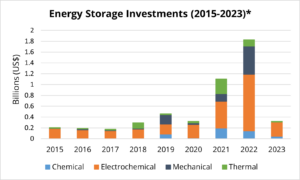True Long-Duration Storage Now Closer to Market Reality, says Cleantech Group
San Francisco, CA – 6 June 2023 — Over 10 developers of energy storage technologies are poised for commercialization as early as 2025, as technological innovation and business models converge on the “sweet spot” of 10-12 hours of storage, according to a study by the Cleantech Group.
The imminent advance is the result of steady investment in energy storage over the past decade, capped by an exponential rise to $1.8 billion last year, emergence of a handful of technologies, such as flow batteries, thermal, mechanical storage and hydrogen, and ambitious net-zero targets.
“The emergence of support schemes like the Inflation Reduction Act (IRA) in the U.S., carbon prices of $100/tCO2 in the European market and increasing penetration of renewables have created a fertile ground for developing new LDES solutions,” said Selene Law, Senior Associate, Energy & Power.
Stakes are high for 19 companies that have successfully demonstrated technology to store electricity for more than 10 hours, with many achieving levelized cost of storage to below $200/MWh, making them competitive with incumbent Li-ion batteries.
“It will not be a one-size-fits-all situation; different LDES solutions will be required for different geographies and technologies,” said Law. “For example, Form Energy’s iron-air technology will not be suitable for balancing solar power. Conversely, vanadium flow will not be the best solution for seasonal storage.”

*Includes Seed, Series A, Series B, and Growth Equity through April 2023. Does not include Li-ion batteries.
“Despite policy support and higher carbon prices, most LDES solutions are not cost competitive yet. I’d like to see more co-operation between innovators and a bigger buy-in from the utilities to see this market really take off,” she added.
Key findings:
- Varied tech needs. Innovation has focused on improving efficiency using brownfield infrastructure and common materials. Simultaneously, it is shaped by geographies. For example, mechanical storage would be suitable for countries with abundant land and high solar penetration, whereas hydrogen would be appropriate for areas focused on wind energy with salt caverns available.
- MIT startup ahead. Form Energy, a startup spun out of the prestigious MIT with technology to make batteries using iron, has attracted the most investment in energy storage — raising nearly $800 million over the past two years.
- Four startups show promise. Energy Dome, Antora Energy, Rondo and Energy Vault are among LDES startups braving high development costs and stiff competition from incumbent publicly traded companies. Each has raised substantial amounts over the last few years. Energy Dome leads the pack with a successful demonstration in under three years.
- EU shows only limited policy support. EU’s Electricity Market Reform or RePowerEU, the European Commission’s plan to make the region free from Russian fossil fuels before 2030, has provided little policy support to LDES. Still, high power prices support higher storage costs, offering market opportunities.
- Global leaders. Spain, Canada and Australia are among leaders outside the U.S. Spain has set a target of 20 GW in grid-scale storage by 2030, while Canada aims for 12 GW. In Australia, the province of New South Wales is targeting 2 GW, while the country’s Renewable Energy Agency is funding eight storage projects to come online by 2025.
Download our complimentary webinar,“Long-Duration Energy Storage: The Next Frontier or The Next Hype?”.
About Cleantech Group
Cleantech® Group is the world’s leading authority on cleantech innovation. Since 2002, our research, consulting and events have catalyzed opportunities for sustainable growth powered by innovation. At every stage from initial strategy to final deals, we bring corporate change makers, investors, governments and stakeholders from across the ecosystem, the access and customized support they need to thrive in a more digitized, de-carbonized and resource-efficient future.